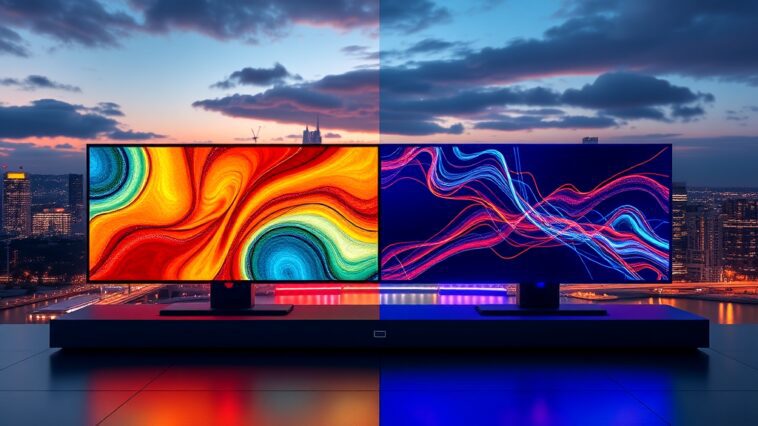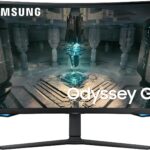When it comes to display technology, two terms have become increasingly popular in recent years: OLED (Organic Light Emitting Diodes) and QD-OLED (Quantum Dot OLED). But what does all this mean for the average consumer, you ask? Well, let’s dive into the specifics and compare these two technologies, highlighting their advantages, differences, and what might be right for you.
Understanding OLED Technology
So, what exactly is OLED? It’s a type of display technology that uses organic compounds to emit light when an electric current is applied. This is kinda cool because it allows for screens that are incredibly thin, flexible, and capable of producing stunning images with deep blacks and vibrant colors.
OLED Technology Advantages Over QD-OLED Displays
One of the major advantages of OLED technology is its ability to produce perfect blacks. Since each pixel emits its own light, when a pixel is off, it’s completely black. This leads to an infinite contrast ratio, which is essential for a truly immersive viewing experience. Now, you might be wondering, “But what about QD-OLED?”
The Rise of QD-OLED Technology
QD-OLED is a hybrid technology that combines traditional OLED with quantum dot technology. In essence, quantum dots are tiny semiconductor particles that can emit different colors of light when illuminated. This enhancement allows QD-OLED displays to achieve greater color accuracy and improved brightness compared to standard OLED displays.
Comparing OLED and QD-OLED Performance Metrics
When we get down to performance metrics, OLED displays generally excel in contrast and black levels. However, QD-OLED offers better color volume and brightness. This means that while OLED displays shine in dark environments, QD-OLED displays are often superior in well-lit settings. Have you ever tried watching a movie during the day with the curtains open? It can be tough to see on standard OLED screens, but QD-OLED mitigates that issue.
How QD-OLED Enhances Traditional OLED Displays
By incorporating quantum dots, QD-OLED enhances the color accuracy and brightness of traditional OLED displays. This combination results in a better overall visual experience, especially in high dynamic range (HDR) content. If you’re someone who enjoys watching the latest blockbuster movies or playing video games with vivid graphics, QD-OLED might just be your new best friend.
Differences in Color Accuracy Between OLED and QD-OLED
Color accuracy is a significant factor for anyone interested in display technology. OLED displays can struggle with color accuracy at high brightness levels. On the other hand, QD-OLED addresses this issue by using quantum dots to produce a wider color gamut. This means that colors can appear more vibrant and true to life, making QD-OLED a solid choice for photographers and graphic designers.
Longevity of OLED Compared to QD-OLED Panels
Now, onto longevity. OLED displays have been known to suffer from burn-in, where static images can leave a permanent mark on the display. QD-OLED technology, by contrast, is designed to mitigate this risk, thanks to the way quantum dots interact with light. So, if you’re concerned about your display’s lifespan, QD-OLED might offer a bit more peace of mind.
User Experiences with OLED and QD-OLED Televisions
User experiences with both OLED and QD-OLED televisions have been overwhelmingly positive. However, some users report that while OLED offers stunning visuals, they might miss out on the brightness and vibrancy that QD-OLED provides. It’s a bit like choosing between a cozy candlelit dinner and an extravagant buffet—both have their charm, but your choice depends on the mood you’re in.
Benefits of Using QD-OLED in Modern TV Screens
The benefits of using QD-OLED in modern TV screens include enhanced brightness, improved color accuracy, and a more dynamic viewing experience. With the ability to produce a wider color gamut and maintain brightness levels, QD-OLED becomes an attractive option for consumers looking for the latest and greatest in display technology.
How OLED and QD-OLED Impact Power Consumption
When it comes to power consumption, traditional OLED displays are generally more energy-efficient when displaying dark scenes, thanks to their ability to turn off individual pixels. QD-OLED displays, while requiring slightly more power due to their additional components, still provide a good balance between performance and efficiency. At the end of the day, both technologies are designed to ensure a great viewing experience without breaking the bank on your electricity bill.
Cost Analysis of OLED vs QD-OLED Manufacturing Processes
But let’s talk money—specifically, the cost of manufacturing these displays. OLED displays have been around longer, so the manufacturing process is more established and generally cheaper. QD-OLED, being a newer technology, is still in the process of scaling production, which could mean higher costs for consumers in the short term. If you’re budget-conscious, this is definitely something to keep in mind.
Future Trends in OLED vs QD-OLED Technology Development
As we look ahead, the future of both OLED and QD-OLED technologies seems bright—pun intended. OLED technology will continue to evolve, with manufacturers working on addressing burn-in issues and improving overall efficiency. QD-OLED, on the other hand, is likely to see increased adoption as production processes become more streamlined and costs decrease.
Visual Quality Comparisons: OLED vs QD-OLED
Let’s get back to the visuals, because that’s what it’s all about, right? OLED displays deliver stunning picture quality with deep blacks and vibrant colors. QD-OLED takes it a step further, providing exceptional brightness and a broader color spectrum. If you’ve ever stood in front of a QD-OLED screen, you know that the colors practically pop off the display. It’s like having a mini movie theater in your living room.
Market Adoption Rates for OLED Compared to QD-OLED
When looking at market adoption rates, OLED has been more widely adopted due to its longer presence in the market. However, QD-OLED is gaining traction as consumers become more aware of the benefits it offers. So, if you’re thinking about upgrading, keep an eye on these trends as they develop.
Environmental Impact of OLED Versus QD-OLED Production
Another aspect worth considering is the environmental impact of OLED versus QD-OLED production. Both technologies have their ecological footprints, but OLED displays typically use fewer materials and require less energy during production. QD-OLED, while offering enhanced performance, may involve more complex manufacturing processes and materials. It’s an important factor to weigh, especially if you’re environmentally conscious.
Expert Reviews on OLED and QD-OLED Performance in Gaming
For gamers, the performance of displays can make or break the experience. Expert reviews often highlight the rapid response times and low input lag of OLED displays—a feature that makes them ideal for fast-paced gaming. QD-OLED, with its superior brightness and color accuracy, is also quickly becoming a favorite among gamers. Honestly, I think both technologies have their unique advantages, so it kinda depends on your gaming style.
Technical Specifications of OLED vs QD-OLED Displays
When it comes to technical specifications, there are a few key differences between OLED and QD-OLED displays. OLED panels typically have a resolution of up to 4K, with some models even supporting 8K. QD-OLED displays, while still emerging, are also expected to support these high resolutions while enhancing color and brightness capabilities.
The Final Verdict
So, which is better: OLED or QD-OLED? Well, that’s a loaded question. If you prioritize deep blacks and contrast, traditional OLED may be the way to go. However, if you’re after superior brightness and color performance, QD-OLED is likely your best bet.
Ultimately, it’s all about personal preference and what you value most in a display. Whether you go with the classic charm of OLED or the shiny new features of QD-OLED, you’re bound to have an impressive viewing experience. And let’s be real—who wouldn’t want to binge-watch their favorite series in stunning quality?
In conclusion, as display technologies continue to evolve, both OLED and QD-OLED will likely coexist, each catering to different preferences and needs. So, next time you’re in the market for a new TV, remember the key differences and advantages of both technologies. Happy viewing!
Other Related Articles
- Eizo Foris FS2331 Review
- How Much Power Does a 144Hz Monitor Use? A Deep Dive into Energy Consumption
- Should I Turn On HDR for Gaming? A Comprehensive Guide
- Is iPhone 16 Pro OLED the Best Display Yet?
- Understanding Panel Variance: What It Means for Your Monitor Purchase
- Can You Throw Computer Monitors in the Trash? The Ultimate Guide to Eco-Friendly Disposal
- Understanding VESA ClearMR: The Future of Motion Clarity in Displays
- 4K vs 1080p – Is UHD Worth The Upgrade?
- How To Choose The Right Gaming Monitor: A Comprehensive Guide
- IPS vs OLED Monitors for Color Accuracy: The Ultimate Showdown
- HDMI 2.1: The Future of Home Entertainment and Gaming
- How to Connect Heart Rate Monitor to PC?
- Curved vs Flat TV – Which Should You Choose? The Ultimate Showdown for 2025
- Can You Connect M-Audio Monitors to PC?
- Why Is My PC Showing the Same Display on Two Monitors?
- Why Are Computer Monitors More Expensive Than TVs?
- The Best Flicker-Free Monitors for Eye Care
- Monitors for Mac vs Windows PCs: The Ultimate Showdown
- 1920×1080 vs 2560×1440 – Which One Should I Choose?
- 99219444 Toshiba and Its Revolutionary Features for Tomorrow’s Tech Landscape
- OLED vs QD-OLED: The Showdown of Display Technologies
- What Is DisplayPort 2.1?
- What Is The Best Monitor Size For Gaming?
- 720p vs 1080p vs 1440p vs 4K vs 8K – Which Should I Choose?
- Is An HDR Gaming Monitor Worth It?
- Mini-LED vs MicroLED: What’s the Difference?
- Do Pawn Shops Take Computer Monitors?
- What LG Computer Monitor is as Good as the C3?
- Understanding Pixel Walk and Pixel Inversion
- Curved vs Flat Monitors for Work: Which One is Right for You?
- What Is The Soap Opera Effect?
- 4K vs 1440p Monitors for Video Editing: Which One Should You Choose?
- Do I Have to Attach a Hood to My BenQ Monitor?
- Can You Use Mac as a Monitor for PC?
- What Is G-SYNC And What Does It Do?
- Daz Studios Summoner G8 for the Visionary Artist
- Dell vs HP Monitors for Gaming
- Understanding IPS Technology: A Comprehensive Guide
- 27-Inch Monitors vs 32-Inch Monitors for Productivity
- Understanding Screen Resolution: Why It Matters for Your Displays
- How to Transport Computer Monitors?
- How to Dispose of Computer Monitors?
- What Is 4K Resolution And Is It Worth It?
- How to Pack Computer Monitor for Moving?
- What Is HDR For TVs And Is It Worth It?
- 1440p or 144Hz – Which Is Best For You?
- USB Type-C Explained – Everything You Need To Know
- Samsung’s Exciting Journey into Glasses-Free 3D Displays at Gamescom 2024
- I Have A Problem with My Samsung Odyssey G3 Monitor Setup
- Is A 144Hz Monitor Worth It? A Comprehensive Guide
- Understanding FALD Blooming and the Halo Effect: A Deep Dive
- What Does 144Hz Mean? Understanding Refresh Rates in Simple Terms
- Is an UltraWide Monitor the Right Choice for You?
- Active vs Passive 3D – What’s The Difference?
- Understanding Glare Control in Luminaires for Computer Users
- Why Does My Acer Monitor Keep Going Black?
- Understanding Motion Blur Reduction: A Gamer’s Guide
- How to Connect Studio Monitors to PC?
- Misleading Monitor Specifications You Should Look Out For
- QLED vs OLED – Which Is Best?
- Understanding VESA AdaptiveSync and MediaSync: The Future of Display Technology




